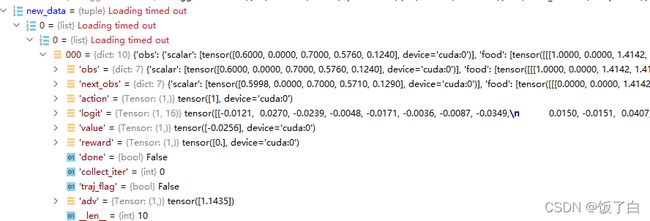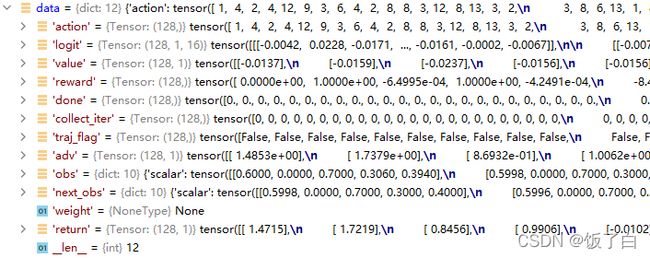PPO实战学习总结
PPO used in go-bigger
前段时间一直在学习ppo算法,写了 一点总结,记录一下自己对ppo算法的一些理解与RL实战时候容易遇到的一些问题。代码地址如下,需要的可以自取:
https://github.com/FLBa9762/PPO_used_in_Gobigger.git
一般DRL在实际使用时根据流程可分类为collect、learn、eval三大过程,所以本文将PPO代码分成这三大过程逐一解析,重点解析learn部分的原理与代码,最后边再附上共享参数的PPO网络模型以供参考
collect
同时输出 action 和 value, 并且保存在buffer中:
output = self._collect_model.forward(data, mode='compute_actor_critic')
保存到 buffer 的数据信息结构如下,其中 tarj_flag是一个标志位,从done信息得来但是将一组数据的最后一个done置为True:

其中;obs下数据的格式为:

每一次采集的数据可以多次输入到learn中进行学习,提高样本的利用率:
for i in range(cfg.policy.learn.update_per_collect):
input_data = copy.deepcopy(train_data)
learner.train(input_data, collector.envstep)
此外,还使用了并行采集,使用了pipe库,具体使用方法还没有掌握
learn
流程
(1)用data中的obs信息和next_obs信息得出value和next_value:并且对value信息进行标准化
with torch.no_grad():
value = self._learn_model.forward(data['obs'], mode='compute_critic')['value']
next_value = self._learn_model.forward(data['next_obs'], mode='compute_critic')['value']
if self._value_norm:
value *= self._running_mean_std.std
next_value *= self._running_mean_std.std
(2)利用data中的数据和value,next_value得出adv信息:
compute_adv_data = gae_data(value, next_value, data['reward'], data['done'], data['traj_flag'])
data['adv'] = gae(compute_adv_data, self._gamma, self._gae_lambda) # 0.9, 0.95
具体步骤在本小节后的关键步骤中。
(3)求return值,并对return和value进行标准化:
unnormalized_returns = value + data['adv']
if self._value_norm:
data['value'] = value / self._running_mean_std.std
data['return'] = unnormalized_returns / self._running_mean_std.std
self._running_mean_std.update(unnormalized_returns.cpu().numpy())
处理后的data数据包含信息如图:

(4)将data数据随机打乱,分组,每组大小为learn_batch,输入到model中进行loss计算,下面代码是计算loss时数据的准备工作(这里要注意data的维度,因为数据的运算全都是并行batch形式,不注意检查很容易就会出现问题,之前在这里吃了大亏):
for batch in split_data_generator(data, self._cfg.learn.batch_size, shuffle=True):
output = self._learn_model.forward(batch['obs'], mode='compute_actor_critic')
adv = batch['adv'].squeeze(-1)
output['logit'] = output['logit'].squeeze(1)
batch['logit'] = batch['logit'].squeeze(1)
if self._adv_norm:
# Normalize advantage in a train_batch
adv = (adv - adv.mean()) / (adv.std() + 1e-5)
(5)将处理后的数据打包输入进行loss计算,clip_ratio一般取0.2:
ppo_batch = ppo_data(output['logit'], batch['logit'], batch['action'], output['value'], batch['value'], adv,batch['return'], batch['weight'])
ppo_loss, ppo_info = ppo_error(ppo_batch, self._clip_ratio)
ppo_error 的具体步骤在本小节后的关键步骤中。
(6)第五步返回的loss有三种类型,分为policy_loss,value_loss和 entropy_loss, 由于actor和critic网络使用了公共参数,并且可以通过添加熵加成来确保足够的探索性。根据PPO论文所指出的(如下图),每次迭代要 最大化以下公式, 这里我的 value_loss 和 entropy_loss 都是和公式一样的,policy_loss我在求的时候就加了负号了(policy_gradient的习惯),所以代码中的 total_loss 写成了如下形式:

wv, we = self._value_weight, self._entropy_weight
total_loss = ppo_loss.policy_loss + wv * ppo_loss.value_loss - we * ppo_loss.entropy_loss
self._optimizer.zero_grad()
total_loss.backward()
self._optimizer.step()
其中,wv和we分别为value_loss和entropy_loss的权重,一般取0.5和0.01
关键步骤
求adv(使用GAE方法)
(1)数据整理,代码如下:
compute_adv_data = gae_data(value, next_value, data['reward'], data['done'], data['traj_flag'])
data['adv'] = gae(compute_adv_data, self._gamma, self._gae_lambda) # 0.9, 0.95
(2)gae函数求每帧数据对应的adv:
def gae(data: namedtuple, gamma: float = 0.99, lambda_: float = 0.97):
value, next_value, reward, done, traj_flag = data
if done is None:
done = torch.zeros_like(reward, device=reward.device)
if len(value.shape) == len(reward.shape) + 1: # for some marl case: value(T, B, A), reward(T, B)
reward = reward.unsqueeze(-1)
done = done.unsqueeze(-1)
delta = reward + (1 - done) * gamma * next_value - value
factor = gamma * lambda_
adv = torch.zeros_like(value, device=value.device)
gae_item = torch.zeros_like(value[0])
for t in reversed(range(reward.shape[0])):
if traj_flag is None: # trag_flag is not None
gae_item = delta[t] + factor * gae_item * (1 - done[t])
else:
gae_item = delta[t] + factor * gae_item * (1 - traj_flag[t].float())
adv[t] += gae_item
return adv
关键的计算公式:
delta = reward + (1 - done) * gamma * next_value - value
用reward、value和next_value信息求的一个大致的基优势
gae_item = delta[t] + factor * gae_item * (1 - traj_flag[t].float())
通过反向迭代,对基优势进行修正,修正后优势包含未来的奖励信息,其中
factor = gamma * lambda_
factor越大,智能体越有远见,但相应模型越难收敛
求loss(policy_loss, value_loss, entropy_loss)
(1)求三个loss,其中ppo_output中包括ppo_loss和entropy_loss,ppo_info中包括approx_kl(新旧策略差异)和 clipfrac(clip的数据占比)。
def ppo_error(
data: namedtuple,
clip_ratio: float = 0.2,
use_value_clip: bool = True,
dual_clip: Optional[float] = None
) -> Tuple[namedtuple, namedtuple]:
assert dual_clip is None or dual_clip > 1.0, "dual_clip value must be greater than 1.0, but get value: {}".format(dual_clip)
logit_new, logit_old, action, value_new, value_old, adv, return_, weight = data
policy_data = ppo_policy_data(logit_new, logit_old, action, adv, weight)
policy_output, policy_info = ppo_policy_error(policy_data, clip_ratio, dual_clip)
value_data = ppo_value_data(value_new, value_old, return_, weight)
value_loss = ppo_value_error(value_data, clip_ratio, use_value_clip)
return ppo_loss(policy_output.policy_loss, value_loss, policy_output.entropy_loss), policy_info
(2)ppo_policy_error()代码:
代码:
def ppo_policy_error(data: namedtuple,
clip_ratio: float = 0.2,
dual_clip: Optional[float] = None) -> Tuple[namedtuple, namedtuple]:
logit_new, logit_old, action, adv, weight = data
if weight is None:
weight = torch.ones_like(adv)
dist_new = torch.distributions.categorical.Categorical(logits=logit_new)
dist_old = torch.distributions.categorical.Categorical(logits=logit_old)
logp_new = dist_new.log_prob(action)
logp_old = dist_old.log_prob(action)
dist_new_entropy = dist_new.entropy()
if dist_new_entropy.shape != weight.shape:
dist_new_entropy = dist_new.entropy().mean(dim=1)
entropy_loss = (dist_new_entropy * weight).mean()
# policy_loss
ratio = torch.exp(logp_new - logp_old)
if ratio.shape != adv.shape:
ratio = ratio.mean(dim=1)
surr1 = ratio * adv
surr2 = ratio.clamp(1 - clip_ratio, 1 + clip_ratio) * adv
if dual_clip is not None: #不执行这里
clip1 = torch.min(surr1, surr2)
clip2 = torch.max(clip1, dual_clip * adv)
# only use dual_clip when adv < 0
policy_loss = -(torch.where(adv < 0, clip2, clip1) * weight).mean()
else:
policy_loss = (-torch.min(surr1, surr2) * weight).mean()
with torch.no_grad():
approx_kl = (logp_old - logp_new).mean().item()
clipped = ratio.gt(1 + clip_ratio) | ratio.lt(1 - clip_ratio)
clipfrac = torch.as_tensor(clipped).float().mean().item()
return ppo_policy_loss(policy_loss, entropy_loss), ppo_info(approx_kl, clipfrac)
其中关键代码:
dist_new = torch.distributions.categorical.Categorical(logits=logit_new)
dist_old = torch.distributions.categorical.Categorical(logits=logit_old)
logp_new = dist_new.log_prob(action)
logp_old = dist_old.log_prob(action)
torch.distributions.categorical.Categorical(logits=< >) 创建一个由logits参数组成的分布(logits是未标准化的概率),pytorch官方手册中是这样描述的

dist_new.log_prob() 是用新旧策略对采样的动作进行处理 (这里具体处理理解的不是很清楚,其实就是对应了ppo算法中求新旧策略的差异) 并得到最后的logp_new和logp_old,(使用log_prob是因为后边方便用对数运算的性质得到 新旧策略的比值作为新旧策略的差异)
log_prob 源码:

ratio就是PPO公式中的r(θ),求法如下:
ratio = torch.exp(logp_new - logp_old)
之后将r(θ)带入clip公式求ppo_loss。weight通常是全为1向量。
policy_loss = (-torch.min(surr1, surr2) * weight).mean()
至于ppo_loss前为何加负号,看公式,由于使用了adv优势,所以我们希望得到更好的奖励,所以希望优势越高越好(最大化 torch.min(surr1, surr2)),根据神经网络的更新原理,可以reduce(-torch.min(surr1, surr2))。
此外,entropy_loss的求解公式为:
dist_new = torch.distributions.categorical.Categorical(logits=logit_new)
dist_new_entropy = dist_new.entropy()
entropy_loss = (dist_new_entropy * weight).mean()
先上pytorch官方源码:

公式很这样看理解起来比较复杂,但是大体上是在求新策略的信息熵(entropy),信息熵的定义是: 表示随机变量不确定的度量,越随机的信源熵越大。 也就是logit_new(未标准化的概率,这段直接叫它概率)概率数组对应的动作不确定度。
例如,如果logit_new 中每个下标对应的概率都一样,动作非常的不确定,那么它的entropy应该就很大,因为此时每个动作的概率都相等,所以logit_new中相当于信息含量很少,它的entropy就很大;相反,在模型训练后期,智能体已经可以根据状态得到一个非常确定的动作了,也就是logit_new中可能会有一个很大的概率和其他很小的概率,那么此时logit_new中信息含量很大,它的entropy也就越小。
(这部分是个人的一点理解,不知道是不是对的)
(3)ppo_value_error()代码:
def ppo_value_error(
data: namedtuple,
clip_ratio: float = 0.2,
use_value_clip: bool = True,
) -> torch.Tensor:
value_new, value_old, return_, weight = data
if weight is None:
weight = torch.ones_like(value_old)
# value_loss
if use_value_clip:
value_clip = value_old + (value_new - value_old).clamp(-clip_ratio, clip_ratio)
v1 = (return_ - value_new).pow(2)
v2 = (return_ - value_clip).pow(2)
value_loss = 0.5 * (torch.max(v1, v2) * weight).mean()
else:
value_loss = 0.5 * ((return_ - value_new).pow(2) * weight).mean()
return value_loss
利用return和value_new构成误差来求value_loss,这里也用到了clip的思想,是为了防止网络更新过快,这里构建方法类似于DQN,就不多余赘述,value_loss的符号为+。
eval
(1)对data信息进行处理后(信息结构为:obs)输入网络求action和logit,代码如下:
with torch.no_grad():
output = self._eval_model.forward(data, mode='compute_actor')
(2)与环境完成一个episode交互后求得评估信息并输出,输出内容如下(可参考使用)
'train_iter': train_iter, # 学习率
'ckpt_name': 'iteration_{}.pth.tar'.format(train_iter),
'episode_count': n_episode,
'envstep_count': envstep_count,
'avg_envstep_per_episode': envstep_count / n_episode,
'evaluate_time': duration,
'avg_envstep_per_sec': envstep_count / duration,
'avg_time_per_episode': n_episode / duration,
'reward_mean': np.mean(episode_reward),
'reward_std': np.std(episode_reward),
'reward_max': np.max(episode_reward),
'reward_min': np.min(episode_reward),
model:
主模型
主模型如下,其中self.encoder为对输入信息进行的特征提取,为Actor和Critic网络的共用部分,self.actor_head为actor网络独有的输出部分,由于本环境使用的动作空间维度为16,因此输出的logit(未归一化的概率) 也是16维的;self.critic_head 为critic网络独有的部分,输出为评价值,维度为1。
mode = [‘compute_actor’, ‘compute_critic’, ‘compute_actor_critic’] 分为三种网络输出模式,可以根据需要选择(官方库的设置非常灵活,可以记录一下这种forward选择方式)
class GoBiggerPPoModel(nn.Module):
mode = ['compute_actor', 'compute_critic', 'compute_actor_critic']
def __init__(self,
scalar_shape: int,
food_shape: int,
food_relation_shape: int,
thorn_relation_shape: int,
clone_shape: int,
clone_relation_shape: int,
hidden_shape: int,
encode_shape: int,
action_type_shape: int,
rnn: bool = False,
critic_head_hidden_size: int = 32,
critic_head_layer_num: int = 1,
activation=nn.ReLU(inplace=True),
) -> None:
super(GoBiggerPPoModel, self).__init__()
self.activation = activation
self.action_type_shape = action_type_shape
self.encoder = Encoder(scalar_shape = scalar_shape,
food_shape = food_shape,
food_relation_shape = food_relation_shape,
thorn_relation_shape = thorn_relation_shape,
clone_shape = clone_shape,
clone_relation_shape = clone_relation_shape,
hidden_shape = hidden_shape,
encode_shape = encode_shape,
activation = activation)
self.actor_head = DiscreteHead(32, action_type_shape, layer_num=2, activation=self.activation)
self.critic_head = RegressionHead(critic_head_hidden_size, 1, critic_head_layer_num,activation=activation)
self.actor = [self.encoder, self.actor_head]
self.critic = [self.encoder, self.critic_head]
self.actor = nn.ModuleList(self.actor)
self.critic = nn.ModuleList(self.critic)
def forward(self, inputs, mode:str):
assert mode in self.mode, "not support forward mode: {}/{}".format(mode, self.mode)
return getattr(self, mode)(inputs)
compute_actor, compute_critic, compute_actor_critic部分的代码:
compute_actor
def compute_actor(self, inputs: torch.Tensor):
B = inputs['batch']
A = inputs['player_num_per_team']
scalar = inputs['scalar']
food = inputs['food']
food_relation = inputs['food_relation']
thorn_relation = inputs['thorn_relation']
thorn_mask = inputs['thorn_mask']
clone = inputs['clone']
clone_relation = inputs['clone_relation']
clone_mask = inputs['clone_mask']
x = self.encoder(scalar, food, food_relation, thorn_relation, thorn_mask, clone,clone_relation, clone_mask)
res = self.actor_head(x)
action_type_logit = res['logit'] # B, M, action_type_size
action_type_logit = action_type_logit.reshape(B, A,*action_type_logit.shape[1:])
return {'logit': action_type_logit,}
compute_critic:
def compute_critic(self, inputs: torch.Tensor):
B = inputs['batch']
A = inputs['player_num_per_team']
scalar = inputs['scalar']
food = inputs['food']
food_relation = inputs['food_relation']
thorn_relation = inputs['thorn_relation']
thorn_mask = inputs['thorn_mask']
clone = inputs['clone']
clone_relation = inputs['clone_relation']
clone_mask = inputs['clone_mask']
x = self.encoder(scalar, food, food_relation, thorn_relation, thorn_mask, clone,clone_relation, clone_mask)
value = self.critic_head(x)
value_pred = value['pred']
value_type_pred = value_pred.reshape(B, A, *value_pred.shape[1:])
value_output_pred = torch.mean(value_type_pred, 1).unsqueeze(-1)
return {'value': value_output_pred}
compute_actor_critic:
def compute_actor_critic(self, inputs:torch.Tensor):
B = inputs['batch']
A = inputs['player_num_per_team']
scalar = inputs['scalar']
food = inputs['food']
food_relation = inputs['food_relation']
thorn_relation = inputs['thorn_relation']
thorn_mask = inputs['thorn_mask']
clone = inputs['clone']
clone_relation = inputs['clone_relation']
clone_mask = inputs['clone_mask']
actor_embedding = critic_embedding = self.encoder(scalar, food, food_relation, thorn_relation,thorn_mask, clone, clone_relation, clone_mask)
act = self.actor_head(actor_embedding)
action_logit = act['logit'] # B, M, action_type_size
action_type_logit = action_logit.reshape(B, A, *action_logit.shape[1:])
value = self.critic_head(critic_embedding)
value_pred = value['pred']
value_type_pred = value_pred.reshape(B, A, *value_pred.shape[1:])
value_output_pred = torch.mean(value_type_pred, 1).unsqueeze(-1)
return {'logit': action_type_logit, 'value': value_output_pred}
写在最后
到这里就结束了,在这次PPO实战中,给我最大的感悟就是真正自己在具体应用中实践完一套RL流程会遇到非常多的问题,远远难于学习一下算法理论或者跑几个官方例程。 真正实践起来还有很多的遗留问题,例如状态空间处理、动作空间的选择,奖励设置,状态标准化等等等等,博主对这些知识了解的还不够系统,日后学习到比较系统的程度之后再进行总结。

